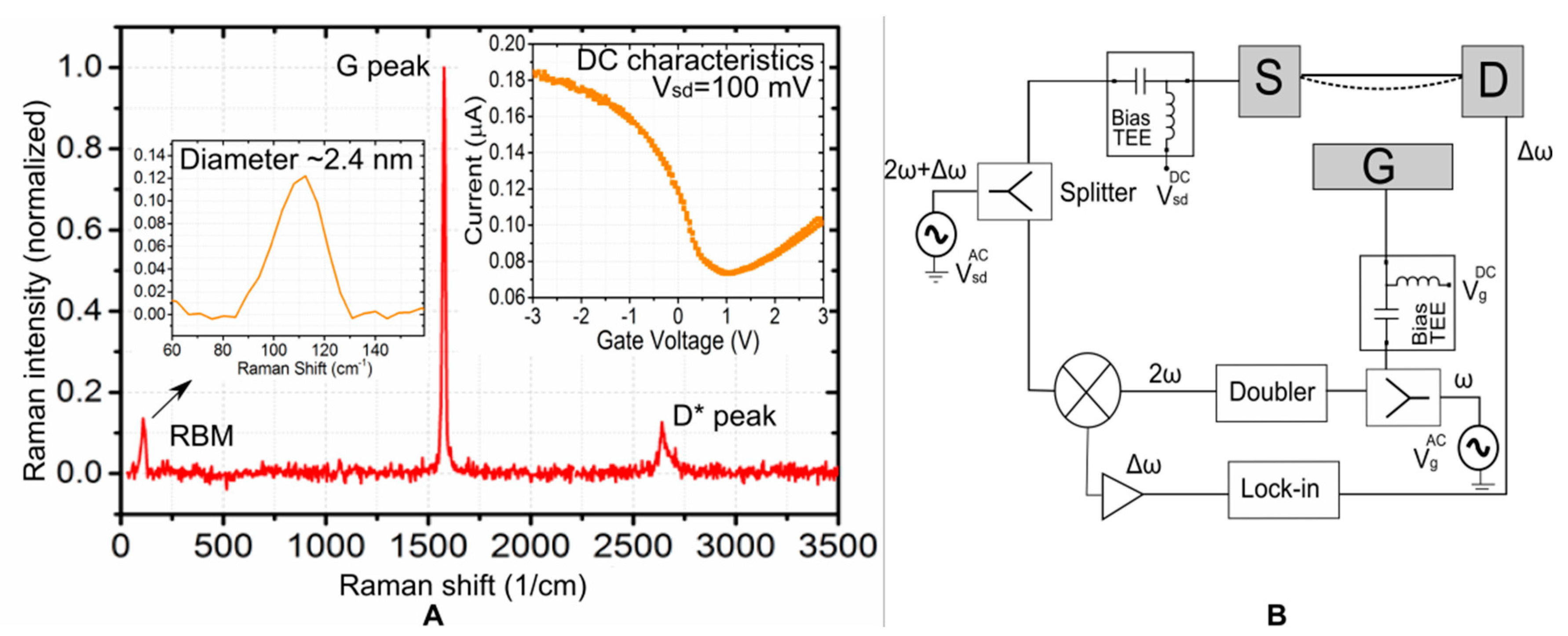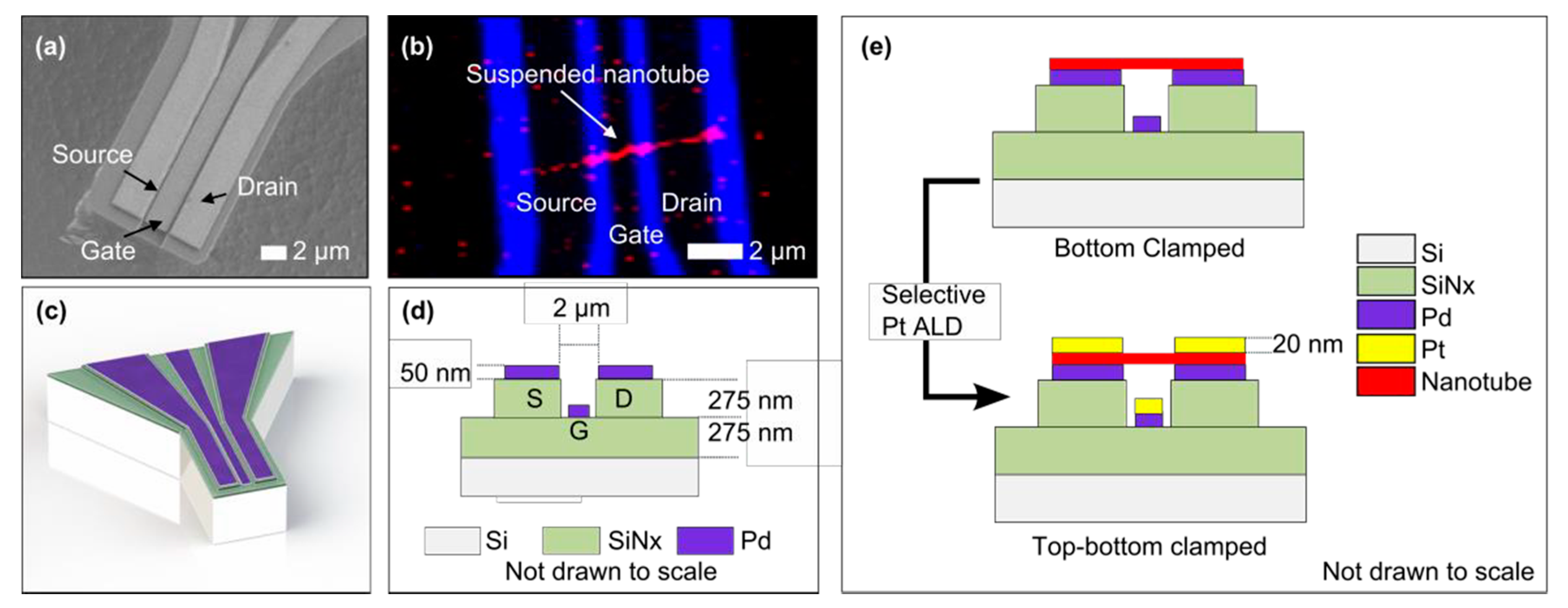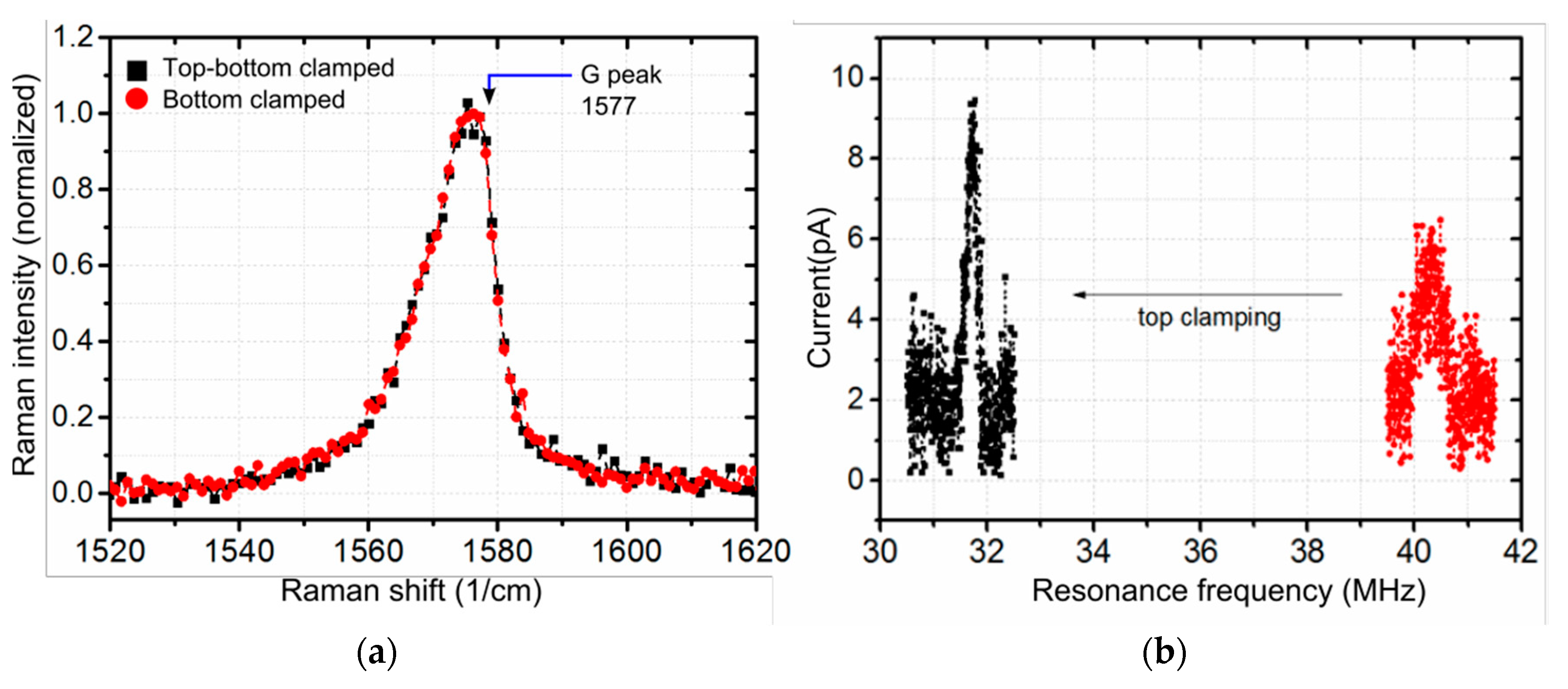Clamping and Q-Factor Improvement in a Carbon Nanotube Resonator †
Abstract
:1. Introduction
2. Fabrication and Methods
3. Experiment and Results
4. Discussion and Conclusions
Author Contributions
Acknowledgments
Conflicts of Interest
Appendix A

References
- Jensen, K.; Peng, H.B.; Zettl, A. Limits of Nanomechanical Resonators. In Proceedings of the International Conference on Nanoscience and Nanotechnology, Brisbane, Australia, 3–7 July 2006. [Google Scholar]
- Ko, J.H.; Jeong, J.; Choi, J.; Cho, M. Quality factor in clamping loss of nanocantilever resonators. Appl. Phys. Lett. 2011, 98, 171909. [Google Scholar] [CrossRef]
- Sazonova, V.; Yaish, Y.; Üstünel, H.; Roundy, D.; Arias, T.A.; McEuen, P.L. A tunable carbon nanotube electromechanical oscillator. Nature 2004, 431, 284–287. [Google Scholar] [CrossRef] [PubMed]
- Imboden, M.; Mohant, P. Dissipation in nanoelectromechanical systems. Phys. Rep. 2014, 534, 89–146. [Google Scholar] [CrossRef]
- Kumar, L.; Jenni, L.V.; Haluska, M.; Roman, C.; Hierold, C. Mechanical stress relaxation in adhesively clamped carbon nanotube resonators. AIP Adv. 2018, 8, 25118. [Google Scholar] [CrossRef]
- Aykol, M.; Hou, B.; Dhall, R.; Chang, S.-W.; Branham, W.; Qiu, J.; Cronin, S.B. Clamping Instability and van der Waals Forces in Carbon Nanotube Mechanical Resonators. Nano Lett. 2014, 14, 2426–2430. [Google Scholar] [CrossRef] [PubMed]
- Jenni, L.V.; Haluska, M.; Hierold, C. Selective metallization and passivation of dry-transferred carbon nanotubes in field-effect transistors. In Proceedings of the 2018 IEEE Micro Electro Mechanical Systems (MEMS), Belfast, UK, 21–25 January 2018; pp. 479–482. [Google Scholar]
- Muoth, M.; Hierold, C. Transfer of carbon nanotubes onto microactuators for hysteresis-free transistors at low thermal budget. In Proceedings of the IEEE 25th International Conference on Micro Electro Mechanical Systems (MEMS), Paris, France, 29 January–2 February 2012; pp. 1352–1355. [Google Scholar]
- Mackus, A.J.M.; Verheijen, M.A.; Leick, N.; Bol, A.A.; Kessels, W.M.M. Influence of Oxygen Exposure on the Nucleation of Platinum Atomic Layer Deposition: Consequences for Film Growth, Nanopatterning, and Nanoparticle Synthesis. Chem. Mater. 2013, 25, 1905–1911. [Google Scholar] [CrossRef]
- Meyer, J.C.; Paillet, M.; Michel, T.; Moréac, A.; Neumann, A.; Duesberg, G.S.; Sauvajol, J.L. Raman Modes of Index-Identified Freestanding Single-Walled Carbon Nanotubes. Phys. Rev. Lett. 2005, 95, 217401. [Google Scholar] [CrossRef] [PubMed]
- Eichler, A.; Moser, J.; Chaste, J.; Zdrojek, M.; Wilson-Rae, I.; Bachtold, A. Nonlinear damping in mechanical resonators made from carbon nanotubes and graphene. Nat. Nanotechnol. 2011, 6, 339–342. [Google Scholar] [CrossRef] [PubMed]
- Takamura, M.; Okamoto, H.; Furukawa, K.; Yamaguchi, H.; Hibino, H. Energy Dissipation in Graphene Mechanical Resonators with and without Free Edges. Micromachines 2016, 7, 158. [Google Scholar] [CrossRef] [PubMed]



Publisher’s Note: MDPI stays neutral with regard to jurisdictional claims in published maps and institutional affiliations. |
© 2018 by the authors. Licensee MDPI, Basel, Switzerland. This article is an open access article distributed under the terms and conditions of the Creative Commons Attribution (CC BY) license (https://creativecommons.org/licenses/by/4.0/).
Share and Cite
Kumar, L.; Jenni, L.V.; Haluska, M.; Roman, C.I.; Hierold, C. Clamping and Q-Factor Improvement in a Carbon Nanotube Resonator. Proceedings 2018, 2, 848. https://doi.org/10.3390/proceedings2130848
Kumar L, Jenni LV, Haluska M, Roman CI, Hierold C. Clamping and Q-Factor Improvement in a Carbon Nanotube Resonator. Proceedings. 2018; 2(13):848. https://doi.org/10.3390/proceedings2130848
Chicago/Turabian StyleKumar, Lalit, Laura Vera Jenni, Miroslav Haluska, Cosmin Ioan Roman, and Christofer Hierold. 2018. "Clamping and Q-Factor Improvement in a Carbon Nanotube Resonator" Proceedings 2, no. 13: 848. https://doi.org/10.3390/proceedings2130848
APA StyleKumar, L., Jenni, L. V., Haluska, M., Roman, C. I., & Hierold, C. (2018). Clamping and Q-Factor Improvement in a Carbon Nanotube Resonator. Proceedings, 2(13), 848. https://doi.org/10.3390/proceedings2130848



